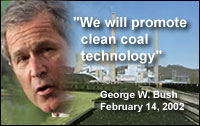|

The use of coal as an energy source has
been known for quite a long time, and there are records of burning
the fossil fuel dating back to the 2,000-1,000 B.C.E. (Wikipedeia,
2007). Within the United States, the scientific capacity to create
usable energies from coal wasn't discovered until the mid-eighteenth
century. The discovery of large coal reserves within the Appalachian
Mountains helped fuel new technologies such as the steam engine
which enabled the Industrial Revolution. New applications for
burning coal were subsequently found, and in the late 1800's,
entrepreneurs began generating electricity to provide for commercial
consumption (Adams 2001). The demand for coal skyrocketed to meet
electricity demands for powering cities and industrial plants;
thus, the 'coal revolution' began.
In the late 19th century, the United States
began burning of coal at incredible rates to maintain electricity
demands. In 1899, the coal industry had processed over 250,000,000
pounds of coal (Adams 2001). Throughout the past century, "coal
rushes" followed war times of war, and the combustion of
coal for electricity played a vital role in securing peace and
prosperity. In 1973, the U.S. experienced its first energy crisis
when the Organization of Arab Petroleum Exporting Countries (OAPEC)
stopped oil shipments (1973 Oil crisis, 2007). Although the crisis
had ended and fuel imports resumed, the U.S. began to understand
the importance of energy independence.
Although there are minimal oil reserves
within the boundaries of the United States, it boasts the world's
largest supply of coal. Depending on future consumption rates
and the ability to access the entire reserves, calculations have
predicted that there are enough coal reserves to last for centuries
(Figure 1) (Schrag 2007).

Figure 1. Representation
of coal reserves in the United States (National Mining Association.
(Retrieved on Feb.
13, 2005 from NMA.org,)
The Appalachian Mountains
are the 'Saudi Arabia' of North America" (Reece 2006), and
with increased political instabilities within the Middle East
and in other areas of the world along with rampant declining oil
reserves, coal is the revitalized fuel source for the future.
According to the Energy Information Administration (EIA) 2003
coal production report, the sector produced almost one billion
short tons (Adams 2001).
re
The electric utility companies
are the primary consumers of coal, and they use it to generate
the electricity needs of modern society. Over half of the U.S.
energy needs are met through coal combustion (figure 2) (Babbitt
& Lindner 2005).

Figure 2. U.S.
Fossil Fuel Consumption (2006)
Source: Electric Power Monthly
(2007).
Coal is king and General Electric
states that it is a $25 billion dollar industry (Sioshansi 2005).
Despite increased awareness that coal has detrimental environmental
and long-term economic consequences, the Bush Administration is
focused on the lucrative industry. Despite global concerns of
burning fossil fuels, he is proposing "business-as-usual"
and intends to revamp the old technology by offering billions
of dollars in new subsidies to the coal industry under the "Clean
Coal Power Initiative (CCPI)" (Techline 2004). At the same
time, the Bush administration has levied environmental and safety
regulation at mining facilities (Geller 2003) (West 2007).

Bibliography
Adams, S. (2003).
"US Coal Industry in the Nineteenth Century". EH.Net
Encyclopedia. Edited by Robert Whaples.
< http://eh.net/encyclopedia/article/adams.industry.coal.us
> (2007, February 02).
Babbitt, C.W., A.S.
Lindner (2005). A life cycle of inventory of coal used for electricity
production in Florida. Journal
of Cleaner Production, 13.
Department of Energy
(2004). Clean Coal Power Inititive-Round 2 Selection. Retrieved on
Feb.03, 2007 from < http://www.fossil.energy.gov
>.
Electric Power Monthly:
January 2007 (2007).
<http://www.eia.doe.gov/cneaf/electricity/epm/epm_sum.html>
(2007, February 01).
Geller, H. (2003).
Energy Revolution. Washington, Island Press
Reece, E. (2006).
Lost Mountain: Radical Strip Mining and the Devastation of
Appalachia. New York: Penguin Group.
Schrag, D.P. (2007,
February). Sustainability and Energy Perspective: Preparing to
Capture Carbon. Science.
Sioshanis, F.P. (2005).
Global Climate Change: Here to Stay. Utilities Policy,
13.
West, L. (2007).
Carbon Dioxide Appeal May Be Most Important Environmental Case
in
Court History. < http://enviornment.about.com/environmentalpolicy
> (2007, February13).
Wikipedia (2007).
History of Coal Mining.
<http://en.wikipedia.org/wiki/Hisotry_of_coal_mining>
(2007, February 14).
|